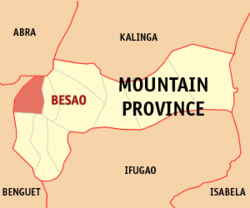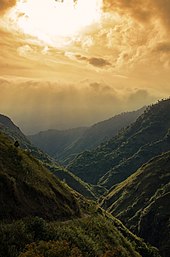Besao
Besao | |
|---|---|
| Municipality of Besao | |
 | |
 Map of Mountain Province with Besao highlighted | |
Location within the Philippines | |
| Coordinates: 17°05′43″N 120°51′22″E / 17.0953°N 120.8561°E | |
| Country | Philippines |
| Region | Cordillera Administrative Region |
| Province | Mountain Province |
| District | Lone district |
| Founded | 1904 |
| Barangays | 14 (see Barangays) |
| Government | |
| • Type | Sangguniang Bayan |
| • Mayor | Bryne O. Bacwaden |
| • Vice Mayor | Elizabeth A. Buyagan |
| • Representative | Maximo Y. Dalog Jr. |
| • Municipal Council | Members |
| • Electorate | 6,152 voters (2022) |
| Area | |
• Total | 173.62 km2 (67.04 sq mi) |
| Elevation | 1,405 m (4,610 ft) |
| Highest elevation | 2,059 m (6,755 ft) |
| Lowest elevation | 721 m (2,365 ft) |
| Population (2020 census)[3] | |
• Total | 6,873 |
| • Density | 40/km2 (100/sq mi) |
| • Households | 1,738 |
| Economy | |
| • Income class | 5th municipal income class |
| • Poverty incidence | 6.82 |
| • Revenue | ₱ 84.37 million (2020) |
| • Assets | ₱ 228 million (2020) |
| • Expenditure | ₱ 65.53 million (2020) |
| • Liabilities | ₱ 25.75 million (2020) |
| Service provider | |
| • Electricity | Mountain Province Electric Cooperative (MOPRECO) |
| Time zone | UTC+8 (PST) |
| ZIP code | 2618 |
| PSGC | |
| IDD : area code | +63 (0)74 |
| Native languages | Balangao Bontoc Ilocano Tagalog Northern Kankanay |
| Website | besao |
Besao, officially the Municipality of Besao is a municipality in the province of Mountain Province, Philippines. According to the 2020 census, it has a population of 6,873 people.[3].
Besao is 27 kilometres (17 mi) from Bontoc and 403 kilometres (250 mi) from Manila.
The town is known for the Agawa people's Agricultural Stone Calendar of Gueday. The stone calendar is one of the most enigmatic artifact in the Cordillera mountains. It is a testimony to the accurate scientific outlook of the ancient Agawa people in the cycle of weathers, agriculture, and heavenly bodies.[5]
Geography
[edit]
Barangays
[edit]Besao is politically subdivided into 14 barangays. Each barangay consists of puroks and some have sitios.
- Agawa
- Ambagiw
- Banguitan
- Besao East
- Besao West
- Catengan
- Gueday
- Kin-iway (Poblacion)
- Lacmaan
- Laylaya
- Padangaan
- Payeo
- Suquib
- Tamboan
Climate
[edit]| Climate data for Besao, Mountain Province | |||||||||||||
|---|---|---|---|---|---|---|---|---|---|---|---|---|---|
| Month | Jan | Feb | Mar | Apr | May | Jun | Jul | Aug | Sep | Oct | Nov | Dec | Year |
| Mean daily maximum °C (°F) | 19 (66) |
20 (68) |
21 (70) |
23 (73) |
23 (73) |
22 (72) |
21 (70) |
21 (70) |
21 (70) |
21 (70) |
20 (68) |
19 (66) |
21 (70) |
| Mean daily minimum °C (°F) | 12 (54) |
12 (54) |
13 (55) |
15 (59) |
16 (61) |
17 (63) |
17 (63) |
17 (63) |
16 (61) |
15 (59) |
14 (57) |
13 (55) |
15 (59) |
| Average precipitation mm (inches) | 35 (1.4) |
46 (1.8) |
63 (2.5) |
117 (4.6) |
402 (15.8) |
400 (15.7) |
441 (17.4) |
471 (18.5) |
440 (17.3) |
258 (10.2) |
94 (3.7) |
68 (2.7) |
2,835 (111.6) |
| Average rainy days | 9.9 | 19.5 | 13.9 | 18.9 | 26.0 | 27.3 | 28.9 | 28.5 | 26.1 | 19.7 | 14.5 | 12.8 | 246 |
| Source: Meteoblue (modeled/calculated data, not measured locally)[6] | |||||||||||||
Demographics
[edit]
|
|
| |||||||||||||||||||||||||||||||||||||||||||||||||||
| Source: Philippine Statistics Authority[7][8][9][10] | |||||||||||||||||||||||||||||||||||||||||||||||||||||
The population of the town has been decreasing due to younger generations migrating to cities seeking for work.
Religion
[edit]Besao,old traditional practices such as animal sacrifices (referred to as korban) were once a way to honor Kabunian (GOD), seek favor, ask for forgiveness, as well as for cleansing and thanksgiving. However, Christianity, specifically Episcopalianism, was introduced by American missionaries in the early 1900s, gradually becoming the dominant faith in the region. Besao's other practices include elements of animism. While animist traditions exist, they are not the primary faith of the community. The town is one of the few in the southern Cordillera mountains where aspects of ancestral worship and intangible heritage have been preserved by the older generations. However, with younger generations migrating to cities, these traditions face significant challenges to their continuity. Additionally, Christian groups have been gaining influence in the town, further contributing to changes in its religious landscape.
Economy
[edit]Poverty incidence of Besao
5
10
15
20
25
30
2006
19.20 2009
26.89 2012
16.30 2015
23.17 2018
16.63 2021
6.82 Source: Philippine Statistics Authority[11][12][13][14][15][16][17][18] |
Government
[edit]Local government
[edit]Besao, belonging to the lone congressional district of the province of Mountain Province, is governed by a mayor designated as its local chief executive and by a municipal council as its legislative body in accordance with the Local Government Code. The mayor, vice mayor, and the councilors are elected directly by the people through an election which is being held every three years.
Elected officials
[edit]Members of the Municipal Council (2019–2022):[19]
- Congressman: Maximo Y. Dalog Jr.
- Mayor: Johnson D. Bantog II
- Vice-Mayor: June T. Lopsoten
- Councilors:
- Bryne O. Bacwaden
- Joel D. Lacsigen
- Elizabeth A. Buyagan
- John M. Antiyag
- Dennis L. Bing-il
- Edna S. Kidangen
- James B. Badongen Sr.
- William S. Beswilan
References
[edit]- ^ Municipality of Besao | (DILG)
- ^ "2015 Census of Population, Report No. 3 – Population, Land Area, and Population Density" (PDF). Philippine Statistics Authority. Quezon City, Philippines. August 2016. ISSN 0117-1453. Archived (PDF) from the original on May 25, 2021. Retrieved July 16, 2021.
- ^ a b Census of Population (2020). "Cordillera Administrative Region (CAR)". Total Population by Province, City, Municipality and Barangay. Philippine Statistics Authority. Retrieved 8 July 2021.
- ^ "PSA Releases the 2021 City and Municipal Level Poverty Estimates". Philippine Statistics Authority. 2 April 2024. Retrieved 28 April 2024.
- ^ "Secrets of the Calendar Stone of Besao in the Philippines Revealed". 4 June 2009.
- ^ "Besao: Average Temperatures and Rainfall". Meteoblue. Retrieved 8 March 2020.
- ^ Census of Population (2015). "Cordillera Administrative Region (CAR)". Total Population by Province, City, Municipality and Barangay. Philippine Statistics Authority. Retrieved 20 June 2016.
- ^ Census of Population and Housing (2010). "Cordillera Administrative Region (CAR)" (PDF). Total Population by Province, City, Municipality and Barangay. National Statistics Office. Retrieved 29 June 2016.
- ^ Censuses of Population (1903–2007). "Cordillera Administrative Region (CAR)". Table 1. Population Enumerated in Various Censuses by Province/Highly Urbanized City: 1903 to 2007. National Statistics Office.
- ^ "Province of Mountain Province". Municipality Population Data. Local Water Utilities Administration Research Division. Retrieved 17 December 2016.
- ^ "Poverty incidence (PI):". Philippine Statistics Authority. Retrieved December 28, 2020.
- ^ "Estimation of Local Poverty in the Philippines" (PDF). Philippine Statistics Authority. 29 November 2005.
- ^ "2003 City and Municipal Level Poverty Estimates" (PDF). Philippine Statistics Authority. 23 March 2009.
- ^ "City and Municipal Level Poverty Estimates; 2006 and 2009" (PDF). Philippine Statistics Authority. 3 August 2012.
- ^ "2012 Municipal and City Level Poverty Estimates" (PDF). Philippine Statistics Authority. 31 May 2016.
- ^ "Municipal and City Level Small Area Poverty Estimates; 2009, 2012 and 2015". Philippine Statistics Authority. 10 July 2019.
- ^ "PSA Releases the 2018 Municipal and City Level Poverty Estimates". Philippine Statistics Authority. 15 December 2021. Retrieved 22 January 2022.
- ^ "PSA Releases the 2021 City and Municipal Level Poverty Estimates". Philippine Statistics Authority. 2 April 2024. Retrieved 28 April 2024.
- ^ "2019 National and Local Elections" (PDF). Commission on Elections. Retrieved March 13, 2022.




